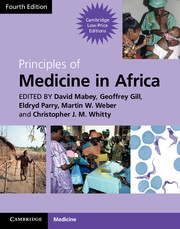Book contents
- Frontmatter
- Contents
- Contributors
- Foreword
- Section 1 Health and disease
- Section 2 Mother and child health
- Section 3 Infection: general principles
- Section 4 Major common infections
- 16 Malaria
- 17 HIV/AIDS
- 18 Tuberculosis
- 19 Pneumonia in adults
- 20 Meningitis
- 21 Sexually transmitted infections
- Section 5 Bacterial infections
- Section 6 Viral Infections
- Section 7 Protozoal infections
- Section 8 Helminth infections
- Section 9 Fungal infections
- Section 10 Non-communicable diseases
- Section 11 Diseases of body systems
- Section 12 Cancer and Palliative Care
- Section 13 Venoms and Poisons
- Index
- References
16 - Malaria
from Section 4 - Major common infections
Published online by Cambridge University Press: 05 March 2013
- Frontmatter
- Contents
- Contributors
- Foreword
- Section 1 Health and disease
- Section 2 Mother and child health
- Section 3 Infection: general principles
- Section 4 Major common infections
- 16 Malaria
- 17 HIV/AIDS
- 18 Tuberculosis
- 19 Pneumonia in adults
- 20 Meningitis
- 21 Sexually transmitted infections
- Section 5 Bacterial infections
- Section 6 Viral Infections
- Section 7 Protozoal infections
- Section 8 Helminth infections
- Section 9 Fungal infections
- Section 10 Non-communicable diseases
- Section 11 Diseases of body systems
- Section 12 Cancer and Palliative Care
- Section 13 Venoms and Poisons
- Index
- References
Summary
The problem in Africa
Malaria is one of the major diseases of Africa and one of the commonest reasons for outpatient attendance in most hospitals. Over 90 per cent of this is the potentially fatal P. falciparum species. A recent estimate suggested that, in 2007, 182 million African children under 5 with fever were likely to have sought treatment in a public sector clinic of which 78 million (43 per cent) were likely to have been infected with P. falciparum (Gething et al., 2010). The actual number of cases will be higher; in most countries the majority of children with malaria never get to public sector health care.
Malaria is a major cause of severe morbidity and mortality in children and pregnant women throughout Africa between the Sahara and South Africa. Currently, most non-pregnant adults in malaria-endemic Africa have sufficient immunity following repeated exposure to prevent them dying of malaria, so in adults it is a much smaller problem. Immunity to severe malaria cannot be assumed, however, especially in adults from low transmission settings such as urban or highland areas, or where there is good malaria control.
Diagnosed early and correctly, almost all cases of malaria in Africa should be curable with widely available drugs. When definitive treatment is delayed, often due to delayed presentation or treatment with ineffective drugs, malaria can be a severe disease causing significant mortality in children, and adults especially in pregnant women. Since the third edition of this book, the incidence of malaria has dropped significantly in a number of countries in Africa, notably Zambia, parts of Kenya, Zanzibar and parts of Tanzania, Rwanda and The Gambia. Despite this, malaria remains a major public health problem even in these countries and one of the leading causes of mortality in other African countries. The changing epidemiology of malaria is likely to present new challenges over the life-time of this textbook.
- Type
- Chapter
- Information
- Principles of Medicine in Africa , pp. 182 - 194Publisher: Cambridge University PressPrint publication year: 2013
References
- 1
- Cited by



